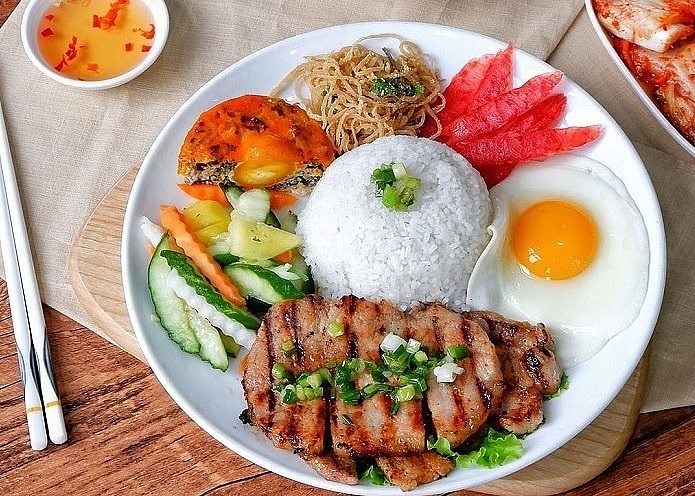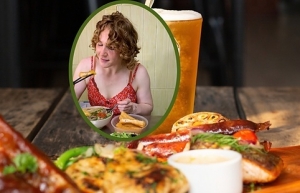Broken rice ranks second among top 100 most tasty rice dishes in Asia by TasteAtlas
 |
| Broken rice (or com tam) has become a must-try dish for locals, foreign visitors, and travellers to Vietnam. |
Hanoi - Vietnam’s broken rice (locally known as com tam) was chosen the second place among the top 100 most tasty rice dishes in Asia by TasteAtlas, the home of local food, traditional restaurants, and authentic recipes, in March this year.
This traditional dish of Vietnam is cooked from broken rice, once considered food for the poor. Still, nowadays, it has become a special popular dish in the country, particularly in Hanoi and HCM City, TasteAtlas said, noting that Japanese sushi ranked first.
A friend of mine, Chiam Jia Xine from Malaysia, said during his recent trip to Hanoi, he was interested in not only bun cha (vermicelli with grilled pork and fresh herbs) and rau muong xao (fried morning glory with garlic) but also broken rice.
“I like broken rice eaten with grilled sour and sweet pork ribs and salad made from the mix of cucumber, tomato slices, minced garlic and chilli,” he said, noting that he enjoyed the dish because the rice is soft, fragrant and sweet.
Different from the Vietnamese habit of using chopsticks, this rice dish is used table wares like those of Western people, he commented.
Came into being from Sai Gon (now HCM City) in the early 20th century, when the country had entered into the urbanisation process, broken rice has become popular in almost southern provinces to meet increasing demands, said HCM City resident Dang Hong Minh, 80.
When becoming the country’s biggest tourism hub, luring a lot of foreign tourists, travellers, and businesses, sellers in the city have served table wares to make the dish suitable for foreign guests instead of using chopsticks and bowls as before, Minh said.
Today com tam has become a symbol of Saigon cuisine. It is often said that “Saigon people eat broken rice as much as Hanoians eat pho (noodle soup)”.
In the past, com tam was considered rice for poor people because the broken rice was considered chicken food. But when people discovered it's tastier and rich in protein and vitamins such as B1, it became a famous speciality that local dinners and foreigners wish to enjoy, Minh said.
The main ingredients to be eaten with a com tam plate include grilled sour and sweet pork ribs, nem chao (boiled pork skin cut into threads, cut bacon mixed with fish sauce, roasted rice powder and spice) and many others.
Restaurants are serving broken rice with fried tofu, braised pork and steamed egg mixed with minced pork, vermicelli pieces, wood ears, fragrant mushroom, fresh onions and spicy (locally known as com tam cha); fried fish, and boiled chicken, said Minh.
There are different styles of com tam. They include broken rice cooked in a tinny earthen pot, fried broken rice in Vietnamese or Thai recipes or com chao, which means broken rice, vegetable, meat and eggs are poured into the pan, stirred and enjoyed hot.
In 2012, CNN remarked street broken rice is an attractive and popular dish in Saigon, while in August of the same year, the Asia Book of Records recognised Saigon broken cuisine value together with nine other Vietnamese dishes.
Furthermore, EBS TV of the Republic of Korea also praised broken rice as the special characteristics dish of Saigon, saying those visiting the city and failing to try the dish may not fully understand it.
 | American food blogger with love for Vietnamese street food A passion for street food has inspired American actress Corrin Carlson to become a food blogger giving reviews about food, restaurants, travel, and daily life during her three-year stay in Vietnam. |
What the stars mean:
★ Poor ★ ★ Promising ★★★ Good ★★★★ Very good ★★★★★ Exceptional
Related Contents
Latest News
More News
- GBA Oktoberfest 2025 celebrates German-Vietnam ties (September 29, 2025 | 23:52)
- Showcase AC 2025 set to light up Hanoi stage (September 12, 2025 | 18:06)
- GBA Oktoberfest Vietnam returns with landmark edition (September 07, 2025 | 11:52)
- New Zealand art exhibition to strengthen Vietnam cultural links (August 16, 2025 | 12:16)
- LG art exhibition marks three decades of development in Vietnam (July 31, 2025 | 14:38)
- Maxilite by Dulux launches national contest for painters (July 28, 2025 | 12:16)
- Runners gear up as Sedona SkyRun makes a comeback (June 30, 2025 | 17:28)
- Innovative concert brings symphonic music closer to Vietnamese audience (June 24, 2025 | 09:39)
- Panasonic kicks off Kid Witness News 2025 to enrich children’s summer (June 12, 2025 | 18:25)
- Danang dances in the fireworks limelight (June 09, 2025 | 11:00)

 Tag:
Tag:


















 Mobile Version
Mobile Version